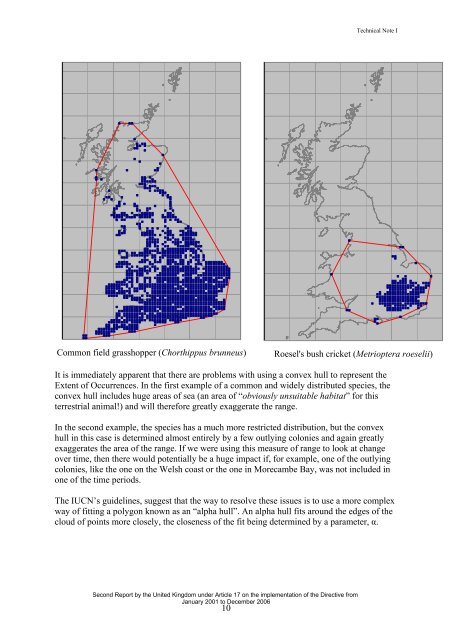Technical Note I AlphaShapes range calculation tool - JNCC
Technical Note I AlphaShapes range calculation tool - JNCC
Technical Note I AlphaShapes range calculation tool - JNCC
You also want an ePaper? Increase the reach of your titles
YUMPU automatically turns print PDFs into web optimized ePapers that Google loves.
<strong>Technical</strong> <strong>Note</strong> I<br />
Common field grasshopper (Chorthippus brunneus)<br />
Roesel's bush cricket (Metrioptera roeselii)<br />
It is immediately apparent that there are problems with using a convex hull to represent the<br />
Extent of Occurrences. In the first example of a common and widely distributed species, the<br />
convex hull includes huge areas of sea (an area of “obviously unsuitable habitat” for this<br />
terrestrial animal!) and will therefore greatly exaggerate the <strong>range</strong>.<br />
In the second example, the species has a much more restricted distribution, but the convex<br />
hull in this case is determined almost entirely by a few outlying colonies and again greatly<br />
exaggerates the area of the <strong>range</strong>. If we were using this measure of <strong>range</strong> to look at change<br />
over time, then there would potentially be a huge impact if, for example, one of the outlying<br />
colonies, like the one on the Welsh coast or the one in Morecambe Bay, was not included in<br />
one of the time periods.<br />
The IUCN’s guidelines, suggest that the way to resolve these issues is to use a more complex<br />
way of fitting a polygon known as an “alpha hull”. An alpha hull fits around the edges of the<br />
cloud of points more closely, the closeness of the fit being determined by a parameter, α.<br />
Second Report by the United Kingdom under Article 17 on the implementation of the Directive from<br />
January 2001 to December 2006<br />
10
















